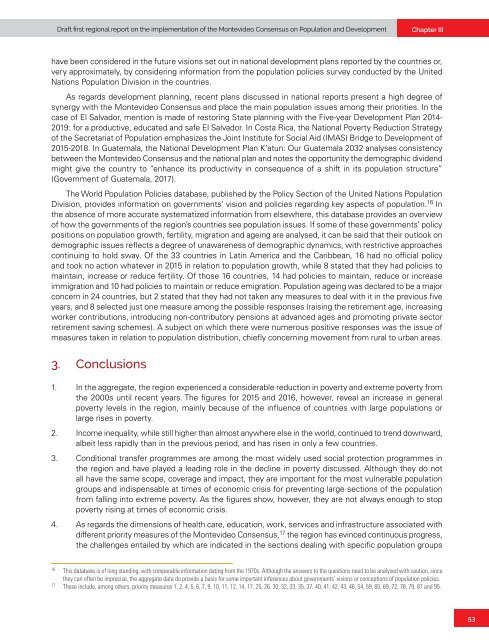Draft first regional report on the implementation of the Montevideo Consensus on Population and Development
This draft report seeks to give an account of progress in the implementation of the priority measures of the Montevideo Consensus on Population and Development in the region, as well as the differences between countries in terms of the degree of implementation. By highlighting relevant national experiences, it also seeks to facilitate the exchange of good practices among countries so that they can benefit from each other in their efforts to advance the implementation of the actions of the Montevideo Consensus.
This draft report seeks to give an account of progress in the implementation of the priority measures of the Montevideo Consensus on Population and Development in the region, as well as the differences between countries in terms of the degree of implementation. By highlighting relevant national experiences, it also seeks to facilitate the exchange of good practices among countries so that they can benefit from each other in their efforts to advance the implementation of the actions of the Montevideo Consensus.
You also want an ePaper? Increase the reach of your titles
YUMPU automatically turns print PDFs into web optimized ePapers that Google loves.
<str<strong>on</strong>g>Draft</str<strong>on</strong>g> <str<strong>on</strong>g>first</str<strong>on</strong>g> <str<strong>on</strong>g>regi<strong>on</strong>al</str<strong>on</strong>g> <str<strong>on</strong>g>report</str<strong>on</strong>g> <strong>on</strong> <strong>the</strong> implementati<strong>on</strong> <strong>of</strong> <strong>the</strong> M<strong>on</strong>tevideo C<strong>on</strong>sensus <strong>on</strong> Populati<strong>on</strong> <strong>and</strong> <strong>Development</strong><br />
Chapter III<br />
have been c<strong>on</strong>sidered in <strong>the</strong> future visi<strong>on</strong>s set out in nati<strong>on</strong>al development plans <str<strong>on</strong>g>report</str<strong>on</strong>g>ed by <strong>the</strong> countries or,<br />
very approximately, by c<strong>on</strong>sidering informati<strong>on</strong> from <strong>the</strong> populati<strong>on</strong> policies survey c<strong>on</strong>ducted by <strong>the</strong> United<br />
Nati<strong>on</strong>s Populati<strong>on</strong> Divisi<strong>on</strong> in <strong>the</strong> countries.<br />
As regards development planning, recent plans discussed in nati<strong>on</strong>al <str<strong>on</strong>g>report</str<strong>on</strong>g>s present a high degree <strong>of</strong><br />
synergy with <strong>the</strong> M<strong>on</strong>tevideo C<strong>on</strong>sensus <strong>and</strong> place <strong>the</strong> main populati<strong>on</strong> issues am<strong>on</strong>g <strong>the</strong>ir priorities. In <strong>the</strong><br />
case <strong>of</strong> El Salvador, menti<strong>on</strong> is made <strong>of</strong> restoring State planning with <strong>the</strong> Five-year <strong>Development</strong> Plan 2014-<br />
2019: for a productive, educated <strong>and</strong> safe El Salvador. In Costa Rica, <strong>the</strong> Nati<strong>on</strong>al Poverty Reducti<strong>on</strong> Strategy<br />
<strong>of</strong> <strong>the</strong> Secretariat <strong>of</strong> Populati<strong>on</strong> emphasizes <strong>the</strong> Joint Institute for Social Aid (IMAS) Bridge to <strong>Development</strong> <strong>of</strong><br />
2015-2018. In Guatemala, <strong>the</strong> Nati<strong>on</strong>al <strong>Development</strong> Plan K’atun: Our Guatemala 2032 analyses c<strong>on</strong>sistency<br />
between <strong>the</strong> M<strong>on</strong>tevideo C<strong>on</strong>sensus <strong>and</strong> <strong>the</strong> nati<strong>on</strong>al plan <strong>and</strong> notes <strong>the</strong> opportunity <strong>the</strong> demographic dividend<br />
might give <strong>the</strong> country to “enhance its productivity in c<strong>on</strong>sequence <strong>of</strong> a shift in its populati<strong>on</strong> structure”<br />
(Government <strong>of</strong> Guatemala, 2017).<br />
The World Populati<strong>on</strong> Policies database, published by <strong>the</strong> Policy Secti<strong>on</strong> <strong>of</strong> <strong>the</strong> United Nati<strong>on</strong>s Populati<strong>on</strong><br />
Divisi<strong>on</strong>, provides informati<strong>on</strong> <strong>on</strong> governments’ visi<strong>on</strong> <strong>and</strong> policies regarding key aspects <strong>of</strong> populati<strong>on</strong>. 16 In<br />
<strong>the</strong> absence <strong>of</strong> more accurate systematized informati<strong>on</strong> from elsewhere, this database provides an overview<br />
<strong>of</strong> how <strong>the</strong> governments <strong>of</strong> <strong>the</strong> regi<strong>on</strong>’s countries see populati<strong>on</strong> issues. If some <strong>of</strong> <strong>the</strong>se governments’ policy<br />
positi<strong>on</strong>s <strong>on</strong> populati<strong>on</strong> growth, fertility, migrati<strong>on</strong> <strong>and</strong> ageing are analysed, it can be said that <strong>the</strong>ir outlook <strong>on</strong><br />
demographic issues reflects a degree <strong>of</strong> unawareness <strong>of</strong> demographic dynamics, with restrictive approaches<br />
c<strong>on</strong>tinuing to hold sway. Of <strong>the</strong> 33 countries in Latin America <strong>and</strong> <strong>the</strong> Caribbean, 16 had no <strong>of</strong>ficial policy<br />
<strong>and</strong> took no acti<strong>on</strong> whatever in 2015 in relati<strong>on</strong> to populati<strong>on</strong> growth, while 8 stated that <strong>the</strong>y had policies to<br />
maintain, increase or reduce fertility. Of those 16 countries, 14 had policies to maintain, reduce or increase<br />
immigrati<strong>on</strong> <strong>and</strong> 10 had policies to maintain or reduce emigrati<strong>on</strong>. Populati<strong>on</strong> ageing was declared to be a major<br />
c<strong>on</strong>cern in 24 countries, but 2 stated that <strong>the</strong>y had not taken any measures to deal with it in <strong>the</strong> previous five<br />
years, <strong>and</strong> 8 selected just <strong>on</strong>e measure am<strong>on</strong>g <strong>the</strong> possible resp<strong>on</strong>ses (raising <strong>the</strong> retirement age, increasing<br />
worker c<strong>on</strong>tributi<strong>on</strong>s, introducing n<strong>on</strong>-c<strong>on</strong>tributory pensi<strong>on</strong>s at advanced ages <strong>and</strong> promoting private sector<br />
retirement saving schemes). A subject <strong>on</strong> which <strong>the</strong>re were numerous positive resp<strong>on</strong>ses was <strong>the</strong> issue <strong>of</strong><br />
measures taken in relati<strong>on</strong> to populati<strong>on</strong> distributi<strong>on</strong>, chiefly c<strong>on</strong>cerning movement from rural to urban areas.<br />
3. C<strong>on</strong>clusi<strong>on</strong>s<br />
1. In <strong>the</strong> aggregate, <strong>the</strong> regi<strong>on</strong> experienced a c<strong>on</strong>siderable reducti<strong>on</strong> in poverty <strong>and</strong> extreme poverty from<br />
<strong>the</strong> 2000s until recent years. The figures for 2015 <strong>and</strong> 2016, however, reveal an increase in general<br />
poverty levels in <strong>the</strong> regi<strong>on</strong>, mainly because <strong>of</strong> <strong>the</strong> influence <strong>of</strong> countries with large populati<strong>on</strong>s or<br />
large rises in poverty.<br />
2. Income inequality, while still higher than almost anywhere else in <strong>the</strong> world, c<strong>on</strong>tinued to trend downward,<br />
albeit less rapidly than in <strong>the</strong> previous period, <strong>and</strong> has risen in <strong>on</strong>ly a few countries.<br />
3. C<strong>on</strong>diti<strong>on</strong>al transfer programmes are am<strong>on</strong>g <strong>the</strong> most widely used social protecti<strong>on</strong> programmes in<br />
<strong>the</strong> regi<strong>on</strong> <strong>and</strong> have played a leading role in <strong>the</strong> decline in poverty discussed. Although <strong>the</strong>y do not<br />
all have <strong>the</strong> same scope, coverage <strong>and</strong> impact, <strong>the</strong>y are important for <strong>the</strong> most vulnerable populati<strong>on</strong><br />
groups <strong>and</strong> indispensable at times <strong>of</strong> ec<strong>on</strong>omic crisis for preventing large secti<strong>on</strong>s <strong>of</strong> <strong>the</strong> populati<strong>on</strong><br />
from falling into extreme poverty. As <strong>the</strong> figures show, however, <strong>the</strong>y are not always enough to stop<br />
poverty rising at times <strong>of</strong> ec<strong>on</strong>omic crisis.<br />
4. As regards <strong>the</strong> dimensi<strong>on</strong>s <strong>of</strong> health care, educati<strong>on</strong>, work, services <strong>and</strong> infrastructure associated with<br />
different priority measures <strong>of</strong> <strong>the</strong> M<strong>on</strong>tevideo C<strong>on</strong>sensus, 17 <strong>the</strong> regi<strong>on</strong> has evinced c<strong>on</strong>tinuous progress,<br />
<strong>the</strong> challenges entailed by which are indicated in <strong>the</strong> secti<strong>on</strong>s dealing with specific populati<strong>on</strong> groups<br />
16<br />
This database is <strong>of</strong> l<strong>on</strong>g st<strong>and</strong>ing, with comparable informati<strong>on</strong> dating from <strong>the</strong> 1970s. Although <strong>the</strong> answers to <strong>the</strong> questi<strong>on</strong>s need to be analysed with cauti<strong>on</strong>, since<br />
<strong>the</strong>y can <strong>of</strong>ten be imprecise, <strong>the</strong> aggregate data do provide a basis for some important inferences about governments’ visi<strong>on</strong>s or c<strong>on</strong>cepti<strong>on</strong>s <strong>of</strong> populati<strong>on</strong> policies.<br />
17<br />
These include, am<strong>on</strong>g o<strong>the</strong>rs, priority measures 1, 2, 4, 5, 6, 7, 9, 10, 11, 12, 14, 17, 25, 26, 30, 32, 33, 35, 37, 40, 41, 42, 43, 46, 54, 59, 65, 69, 72, 78, 79, 87 <strong>and</strong> 95.<br />
53


















